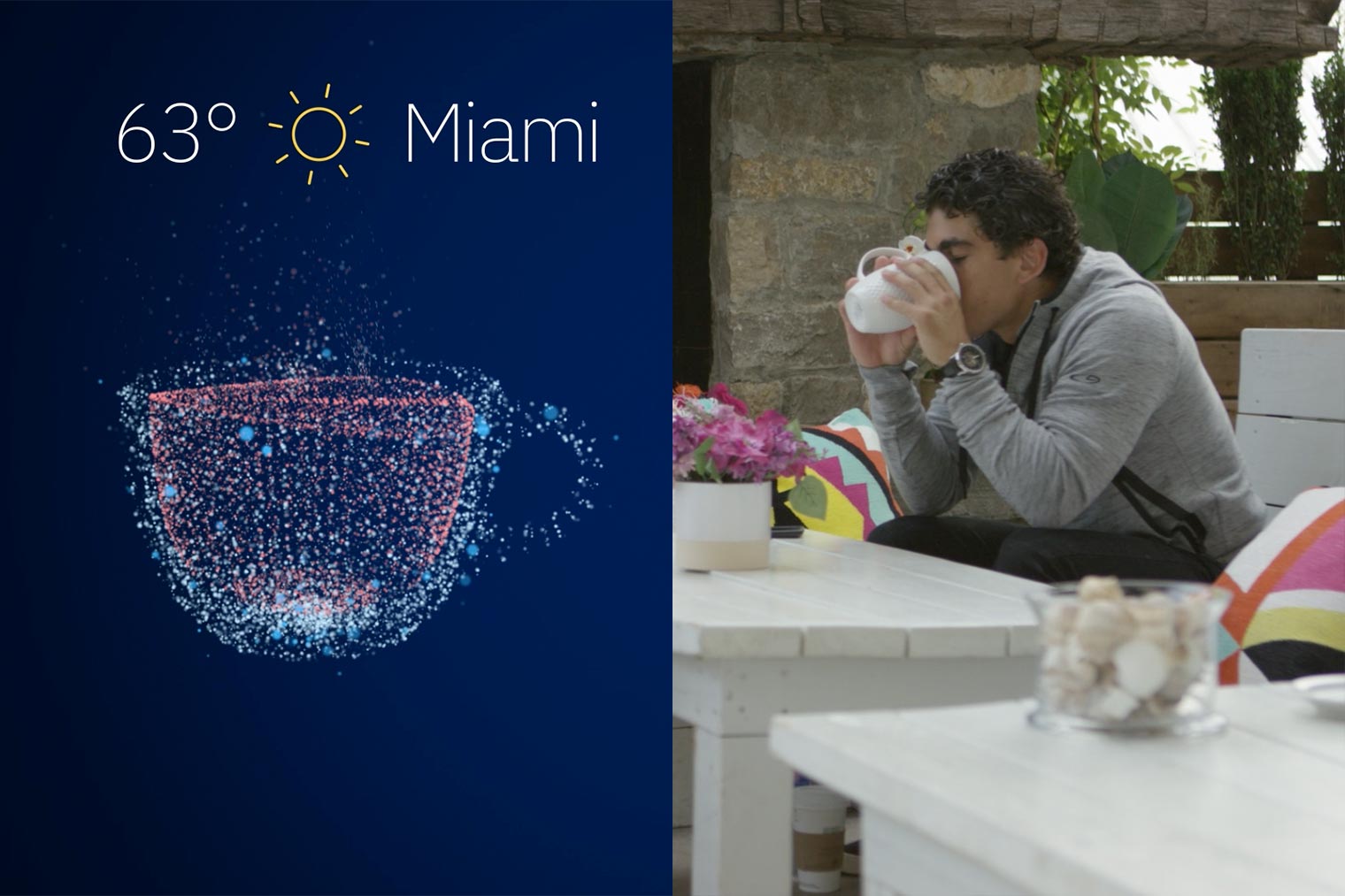Weather intelligence for the future: Crafting a strategic enterprise approach to changing environmental conditions
Continue readingThe advertising industry is in a constant state of evolution. Innovations in technology, such as artificial intelligence (AI), better targeting and dynamic creative, are changing how consumers interact with brands. Companies are also benefiting from better analytics and a more in-depth understanding of how their advertising works. Machine learning can take the guesswork out of capitalizing on vast amounts of data and providing insights that can be applied to AI-based advertising campaigns.
Machine learning in advertising is a process in which technology takes information, analyzes it, and ultimately formulates a conclusion that can improve a task or a process. The insights derived from this technology can be applied to audience targeting, personalization, media buying, and more.
How machine learning works & how it is used in advertising
Machine learning is a form of AI. Its goal is to teach technology to think and operate similarly to humans, allowing machines to continuously learn from past experiences to make predictions about the future.
Machine learning leverages historical data and identifies patterns without the help of human interaction. Essentially any task that utilizes information or requires a set of rules can be streamlined through machine learning technology. Companies can save time and money by automating processes that previously would need human intervention. Employees then have time to solve more complex business problems, leading to more profits and less time on tasks that are time-consuming and mundane.
Five reasons why machine learning can be right for your business
There are numerous benefits for companies that are ready to embrace machine learning as part of their advertising efforts. Below, we have outlined five reasons organizations should implement AI as part of their strategy in attracting new customers and increasing ROI.
1. Better personalization
Personalization delivers a better customer experience by providing more relevant ads. Most consumers also prefer these types of advertisements. Some 8 out of 10 frequent shoppers1 note that they will only buy from companies that personalize the experience. Additionally, about 6 out of 10 customers1 will not buy from organizations that are poorly leveraging personalization tactics. For companies looking to connect with consumers and drive sales, personalization is more important now than it has ever been.
Machine learning sifts through massive amounts of data to deliver more personalized advertisements. These can be delivered via conversational marketing tactics or seasonality, weather, and region. For example, in December, it may make more sense to advertise auto batteries or hot cereal. In January, you may want to advertise severe winter clothing or hiking boots according to consumer trends.
Regionality is also an important factor to consider when you’re considering personalization. For example, a 60-degree day will feel very different to someone who lives in Florida than someone who lives in New York. In New York, someone might put on a light sweater, while in Florida, someone might be wearing a coat and gloves. As a result, you’ll want to personalize your ads accordingly.
2. Better advertising decisions through machine learning and AI
When relying on human decision-making processes, organizations can fall prey to some hurdles that can lead to less-than-optimal choices. It’s hard to separate biases from the analysis and it can be even more difficult to discern what’s important from the vast amounts of data collected. Companies recognize these challenges and are trying to address them with machine learning. Some 65% of organizations that are using, or planning to use AI, cite its importance for informed decision making and analytics as a key reason for implementing these kinds of technologies.
When advertisers use an AI or machine learning-based tool, the algorithm considers all information and data they have on a given topic and uses it to make the best decision possible. Over time, these decisions continue to improve as the algorithm collects more information. The tools can then make better recommendations tailored for the intended target audience.
Better decision-making has become increasingly important for advertisers who want to ensure ads are relevant to the target audience. The wrong advertisement can not only be an annoyance to users, but it can make brands less credible. According to one study, 90% of consumers2 say that messages from companies that are not personally relevant to them are “annoying.”
Creative is not the only place where AI can help advertisers make better choices. The marketplace is continually shifting; as an advertiser, it’s essential to keep up with demand. For example, consumers are increasingly turning to digital shopping rather than entering stores, especially during the pandemic. Machine learning can take these changes into account, decide what is relevant, and determine the next course of action so campaigns are more effective.
3. More personal interactions through 1:1 conversations
Machine learning and AI tools such as conversational marketing can also give customers a more personalized experience at scale. These kinds of tools will become increasingly important as consumers continue to move into a digital world, but still crave that in-store experience. By leveraging AI, advertisers can tailor experiences to provide them with that same personalized touch.
Conversational marketing tools can also help advertisers create unique, personalized engagements with customers throughout multiple touchpoints in the buyer’s journey. This could include customized, interactive banners at the top of their browser or an AI-powered chatbot that helps a customer answer questions and leads them one step further in the sales process.
Additionally, in today’s fast-paced world, consumers are looking for more immediate responses from companies. By leveraging the power of conversation marketing, you can address concerns or questions more quickly, improving customer satisfaction and retention.
4. Better creative based on data
AI can also go beyond traditional A/B testing to make predictions about how creative will perform before the campaign goes live. This is important because it helps marketers become more proactive in their approach to creative instead of reactive, which can lead to more conversions and higher rates of engagement.
One example of how machine learning can optimize the creative elements in your advertisements is by using historical data to determine what kind of colors and messaging will connect with consumers and drive sales. Machine learning can also determine the context of an ad to determine placement of creative. A soon-to-be bride browsing wedding dresses online would be a primary target for ads related to the big event. Creative can also leverage personalization to target users based on location and weather insights. Before a snowstorm, promote mittens and hats at your store; during a hot summer day, encourage people to visit your store in-person.
5. Improve performance without needing cookies
According to industry surveys, many marketers use their budgets inefficiently. However, most budget waste is a result of marketers focusing on reach rather than quality. Showcasing your message to the wrong audience can be a costly mistake.
However, without cookies, it can be difficult for advertisers to leverage data to drive results. Additionally, with new regulations and increased pressure from consumers looking for privacy, companies must also deliver personalized experiences without feeling invasive.
By leveraging machine learning and ad targeting, companies can identify which messages resonate with their audiences. AI can then use contextual signals and accurate weather data to determine which ad is most likely to drive conversions. Machine learning can deliver these campaigns and messages without using cookies, while respecting data privacy.
The promotional effectiveness of machine learning
Machine learning is an effective strategy for advertisers looking to better connect with audiences. AI helps marketers better target and segment audiences, while delivering more personalized experiences. Companies across a wide range of industries have used AI to drive success, including automotive, insurance, finance, retail, and healthcare. Marketing and sales are often among the top functions for machine-learning adoption.
Machine learning applications in marketing and advertising
AI can be a successful tool for companies looking to better connect with customers and prospects. Here are two examples of how brands can combine machine learning and advertising to achieve their business goals. Below are some examples of industries that can benefit by applying AI to their campaigns:
Automotive advertising
With challenges presented by supply chain issues and inflation, automotive manufacturers are facing increased pressure to make sure each dollar counts. By leveraging machine learning, automotive advertising campaigns can be more successful, leading to more conversions and engagement across digital touchpoints.
Retail advertising
Disruptions in the supply chain have also had a profound effect on retailers. However, there is a large opportunity for digital growth. According to McKinsey, the pandemic had led to about 10 years of e-commerce growth over a six month period. Retailers have gotten an influx of new consumer data through this transition. By incorporating AI, retailers can make sure they get the most out of their data for better and more relevant campaigns.
Advertising in healthcare
Digital advertising is becoming more important in healthcare. In fact, five years ago 65% of medtech companies3 did not spend more than 20% of their advertising dollars on digital initiatives. 20% of this surveyed group has since shifted at least half their budget to digital advertising3.
However, these marketers have additional considerations and challenges, since healthcare is a more regulated industry, operating on highly personal information. For healthcare advertisers, it’s important to only deliver personalized experiences on the consumer’s terms. Machine learning can help deliver these campaigns without feeling invasive, since AI relies on privacy-friendly data inputs.
Machine learning advertising case studies
Below are some examples of how businesses have incorporated machine learning into their campaigns:
The Weather Channel uses an AI-powered chatbot for COVID-19 Q&A
The Weather Company realized that it was difficult for its users to know which COVID-19 related information they could trust and where they can find this information. They utilized Conversations technology to develop a COVID-19 Q&A, which is an AI-powered chatbot, reachable on mobile and app. This led to more than 400,000 conversions a month, over 2.6 million total user inputs, and an average of 1 minute engaged with the chatbot.
Subaru advertising uses dynamic creative to boost engagement
Subaru approached The Weather Company looking to reinforce its commitment to safety on the road, especially during harsh weather conditions. To provide drivers with information to keep them safe on the road in all weather conditions, Subaru created a Driving Difficulty Index Commuter Forecast Tool: a new map layer displayed on The Weather Channel’s interactive maps across tablet, mobile, and desktop. This implementation led to increased engagement across the board with a 4-minute average visit to The Weather Channel web and mobile web and 66% of page views were repeat visitors.
How machine learning is shaping the future of advertising
Machine learning can apply data science to targeting and identify audience behavior, allowing for better segmentation. 41% of advertisers are using machine learning to deliver personalization at scale. About 4 of 10 marketers are using AI to better leverage data for decision-making. Machine learning will continue to shape the industry, leading to better relationships with consumers and more successful campaign strategies.
Ready to learn more about how machine learning can help you make better advertising decisions? Contact us today.
Let’s talk
What’s your weather strategy? To learn more about increasing campaign efficiencies and personalizing messages at the most relevant moments, contact our advertising experts today.
Contact us1 50 Stats Showing The Power Of Personalization, Forbes, February 2020.
2 A Reality Check On Advertising Relevancy And Personalization, Forbes, August 2019.
3 The rise of digital marketing in medtetch, McKinsey & Company, September 2021.







